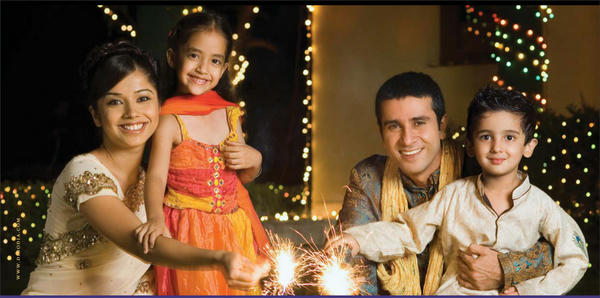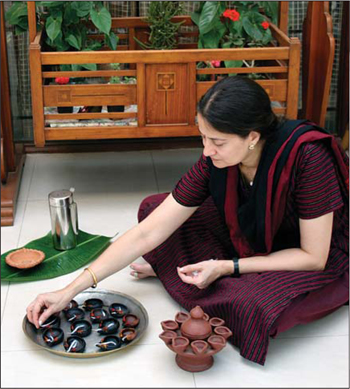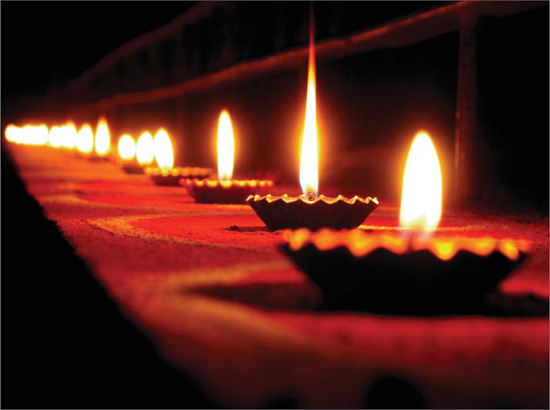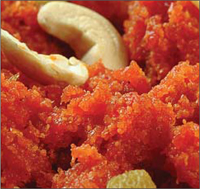
Diwali
Celebrating the Triumph of Goodness
If you rolled a bit of Christmas, New Year’s Eve and the Fourth of July all into one, then catered the affair with mountains of sweets and savory snacks, you would have a taste of what it means to celebrate Diwali, India’s best-known festival. It is a day of Hindu solidarity, when all Hindus gather in love and trust. It is observed by lighting rows of oil lamps and exchanging greeting cards, clothing and other gifts. Family bonds are strengthened and forgiveness sought. For many, Diwali marks the beginning of the new year. Joyous festivities and parties abound. §
What occurs on Diwali?§
Diwali (or Deepavali, “row of lights”) is celebrated by Hindus worldwide to commemorate the triumph of good over evil, knowledge over ignorance, hope over despair. Oil-wick lamps are lit in every household, along with colorful strings of electric lights, causing the home, village and community to sparkle with dancing flames. The festival falls on the day before the new moon in the month of Ashwin (October/November). Communities spare nothing in celebration. Lavish spreads of sweets and treats reflect unfettered partying. Diwali lehyam—a potent concoction made with ginger, pepper, ghee and more—is provided to help gourmands digest the sumptuous feast. Families reach out to each other with gifts of sweets, dried fruit and crunchy, salty treats. Everyone wears colorful new clothing and many even new jewelry. Girls and women decorate their hands with henna designs. §
What does lamp-lighting signify?§
In Hindu culture, light is a powerful metaphor for knowledge and consciousness. It is a reminder of the preciousness of education, self-inquiry and improvement, which bring harmony to the individual, the community and between communities. By honoring light, we affirm the fact that from knowing arises respect for and acceptance of others. Lighting lamps reminds Hindus to keep on the right path, to dispel darkness from their hearts and minds, and to embrace knowledge and goodness. §
What legends are associated with Diwali?§
In the sacred text Ramayana, Diwali marks the return of Rama to his kingdom after defeating Ravana, the demon king who ruled Sri Lanka and kidnapped Rama’s pious wife, Sita. It also celebrates Krishna’s victory over Narakasura, the demon of ignorance. Rama and Krishna are earthly incarnations, or avatars, of Vishnu. §
Does ritual bathing play a part? §
Diwali marks the conquest of negative forces. To wipe away all traces of life’s struggle, the negative and draining energies of strife, Hindus invoke the waters of India’s holiest rivers—Ganga, Yamuna, Godavari, Sarasvati, Narmada, Indus and Kaveri—into water collected in urns in preparation for an ablution after an oil massage. The special bath cleanses the physical and auric energies of the individual. Fragrant powders of dried lentils, roots, aromatic seeds, leaves and flowers are used to remove the oil. Families then don fine new clothes, beautiful patterns are drawn on the ground, and lamps are lit until entire streets glow. Even the White House in Washington, D.C., is illumined by the gentle glow of oil lamps during its annual Diwali observances.§
Tidbits About Diwali
![]() Melas, or fairs, are held in all Indian towns and villages. In the countryside, the mela includes a festive marketplace where farmers bring their produce to sell and clothing vendors have a heyday.§
Melas, or fairs, are held in all Indian towns and villages. In the countryside, the mela includes a festive marketplace where farmers bring their produce to sell and clothing vendors have a heyday.§
![]() Huge effigies of Ravana, with ten heads, are built of straw and filled with firecrackers. They are burned as a joyous, symbolic cleansing from evil, and lights are lit in every home, just as residents of Ayodhya did to welcome home their victorious king, Rama.§
Huge effigies of Ravana, with ten heads, are built of straw and filled with firecrackers. They are burned as a joyous, symbolic cleansing from evil, and lights are lit in every home, just as residents of Ayodhya did to welcome home their victorious king, Rama.§
![]() The following day, families offer special prayers to Lakshmi for a prosperous year. This ritual worship is also directed to Kubera, the celestial being who distributes wealth to mortals. As Hindus pray for comfort and the family’s material wealth, it is believed that things should not be given away or donated on this one day of the year.§
The following day, families offer special prayers to Lakshmi for a prosperous year. This ritual worship is also directed to Kubera, the celestial being who distributes wealth to mortals. As Hindus pray for comfort and the family’s material wealth, it is believed that things should not be given away or donated on this one day of the year.§
Hinduism: Fact & Fiction
FACT: Believing that the Divine resides in all things, Hindus practice non-injury and hold a deep respect, bordering on reverence, for all living beings. This embracing attitude is reflected in India’s history of welcoming refugees from all cultures and faiths. By following dharma, Hindus eschew violence and terror. Secure in their faith, they interact harmoniously with their neighbors, regardless of religious affiliation. §
FICTION: Many people wrongly believe that Hindus, being proud of their religion, may disdain other cultures. In fact, Hindus fully accept the spiritual efficacy of other paths and never proselytize.§
Indian Carrot Sweet
Carrot Halwa
Preparation time: 20 minutes
Cooking time: 60 minutes
Serves: 6-8
Equipment: A small wok or round-bottomed pan, a ladle and a serving dish.§
Ingredients
4 cups/1 kg grated carrots, 1 cup sugar, 2½ cups milk, 1½ ladles
ghee, a few cashews and raisins,
2 cardamom pods§
Method§
- Wash, peel and grate the carrots.
- Fry the cashews, raisins and cardamom in ghee and set aside.
- Heat a ladle of ghee in the pan. Add the grated carrots and sauté.
- Add enough milk to soak the carrots and cook on low heat, stirring occasionally, until carrots are soft. Keep adding milk, a ladle at a time, and cook until the milk thickens, then stir in the sugar.
- Cook over low heat until everything blends together into a firm mass that separates from the sides of the pan.
- Garnish with the fried cashews, cardamom and raisins. Top with a little ghee and pistachio slivers for extra flavor.


